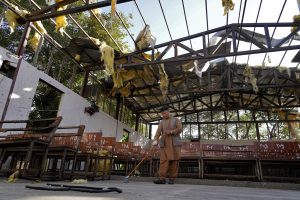Last week’s suicide bombing at a Kabul education center killed as many as 52 people, more than twice the death toll acknowledged by Taliban officials, according to a tally compiled by The Associated Press on Monday.
Dozens more were wounded in Friday’s blast, making it one of the bloodiest attacks since the Taliban seized control of Afghanistan more than a year ago. There was no claim of responsibility, but Islamic State group extremists have carried out a series of attacks against Taliban targets and ethnic minorities.
The blast struck at a time when hundreds of teenage students were taking practice exams at the Kaaj Higher Educational Center in the Afghan capital. The explosion blew the roof off the building.
Taliban security officials initially said 19 people had been killed, then revised the death toll to 25 over the weekend.
However, the AP spoke directly to relatives of 39 of those killed and obtained the names and other information about the remaining 13.
The overwhelming majority of victims were girls and women, including 31 students between the ages of 17 and 20. The youngest victim was a 14-year-old girl called Nasrin, who was visiting the center with her 19-year-old cousin Layeqa, who also died in the blast.
Khalid Zadran, the Taliban-appointed spokesman for the Kabul police chief, said Monday that the death toll was 25, based on information from the Interior Ministry.
Abdul Nafi Takor, a Taliban-appointed spokesman for the Interior Ministry, was not immediately available for comment.
Mohammed Amir buried his 21-year-old daughter Wahida at a Kabul cemetery on Friday. He spoke of the difficult time his family was enduring. “It looks like hell for us,” he said. “I can’t feel anything anymore. I can’t sleep. I feel like I’m being torn apart. I wish I could be somewhere I could shout, raise my voice. My heart is torn for Wahida.”
Wahida’s sister, Zahra, said that Hazaras and Shiites are always under attack. “It is the same this time,” she said. “There were no Sunnis at Kaaj (Educational Center). All of them were Shiites. A suicide bomber entered the girls’ section and detonated himself in front of my sister. All of them were Hazara girls.”
The reason for the lower death toll provided by the Taliban was not immediately clear. In the past, they have at times been slow to confirm casualty figures in the aftermath of attacks.
Since the Taliban takeover of Afghanistan in August 2021, the Islamic State group, a rival of the Taliban, has carried out a series of attacks, including suicide bombings in crowded mosques.
Afghanistan’s minority Hazaras have been a frequent target of the violence. Most Hazaras are Shiite Muslims, despised by Sunni Muslim radicals like the Islamic State group, and discriminated against by many in the Sunni majority country.
The education center targeted Friday is in the Kabul neighborhood of Dashti Barchi, where many of the residents are Hazaras.
In 2020, IS attacked a maternity hospital in Dashti Barchi that killed 24 people, including newborn babies and mothers. In 2021, before the Taliban takeover, the group attacked a school, killing more than 90, most of them schoolgirls.
The neighborhood has seen frequent bombings of minibuses and, earlier this year, a school and another education center were hit near simultaneously, killing six.
The United Nations mission in Afghanistan said 53 people were killed and 110 were wounded in Friday’s bombing. It said in a tweet Monday: “Our human rights team continues documenting the crime: verifying facts & establishing reliable data to counter denial & revisionism.”

































